Phytopathological Disease Diagnostics Market Size
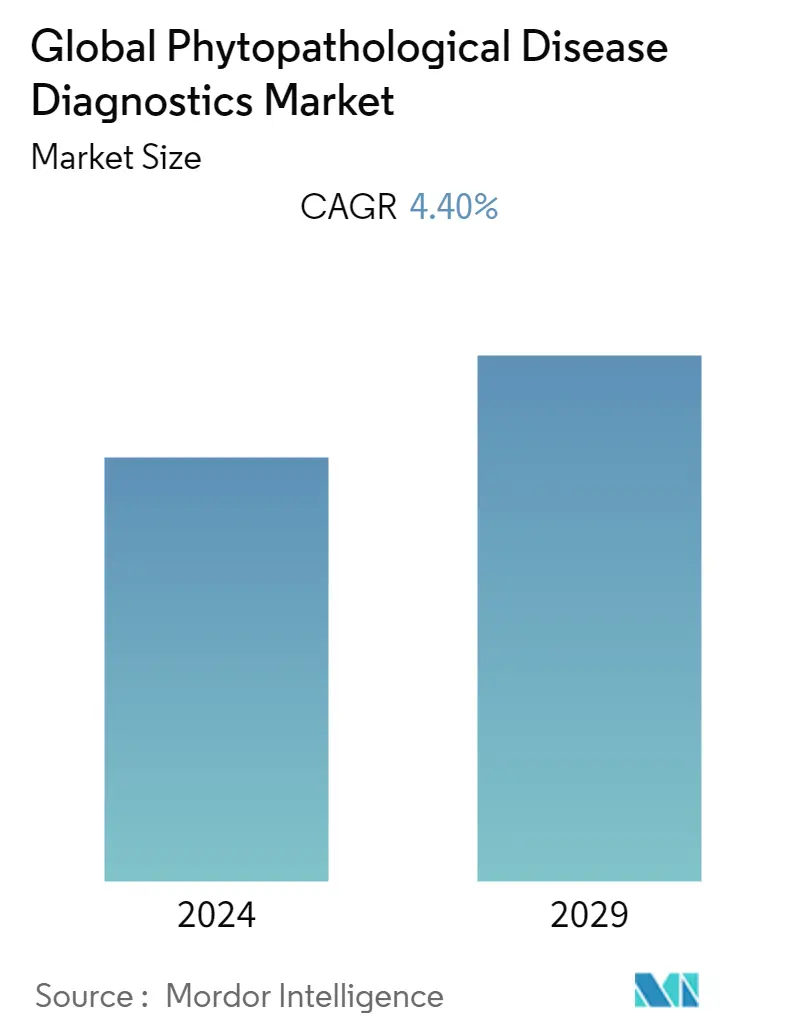
| Study Period | 2019 - 2029 |
| Base Year For Estimation | 2023 |
| Forecast Data Period | 2024 - 2029 |
| CAGR | 4.40 % |
| Fastest Growing Market | Asia Pacific |
| Largest Market | North America |
Major Players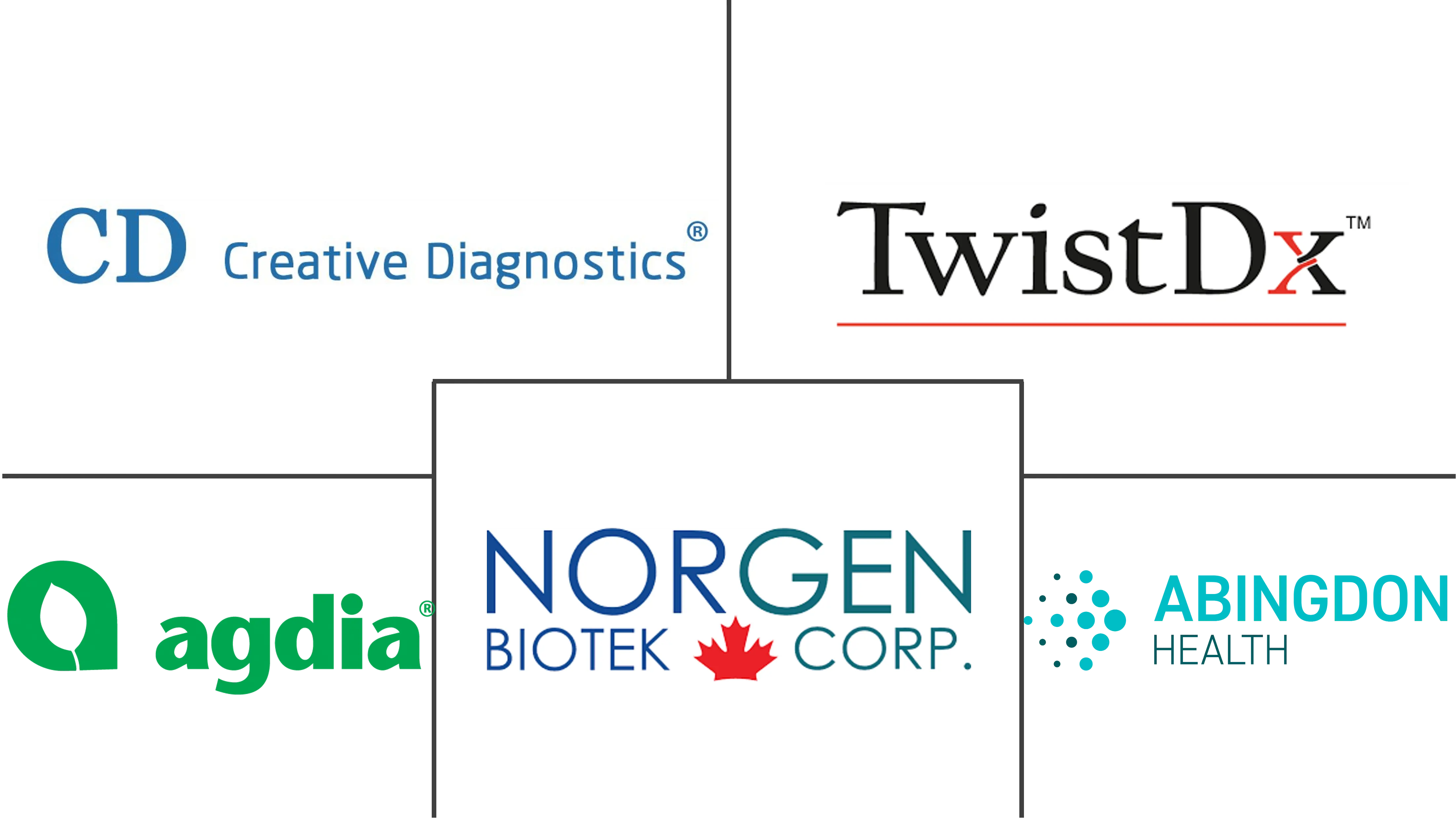
*Disclaimer: Major Players sorted in no particular order |
Phytopathological Disease Diagnostics Market Analysis
The Phytopathological Disease Diagnostics Market is anticipated to grow with a CAGR of nearly 4.4% over the forecast period.
COVID-19 has impacted the crops and plants which has slowed down the market growth. The COVID-19 pandemic's lockdown and quarantine procedures have reduced the production and supply of plant protection products (PPP), which has a negative impact on crop protection actions globally. Also, the disruption in the flow of the plant protection products (PPP) either from local or international suppliers to the farm level, has already resulted in reduced plant yields. For instance, according to an article published in January 2021, titled 'Editorial: Impacts of COVID-19 on global plant health and crop protection and the effect on global food security and safety', it has been observed that the transportation cost of pesticides was doubled, and shipping was delayed in East Africa due to fewer flights to the region which resulted in the serious pests' outbreaks and high loss of the crops. Thus, COVID-19 has impacted the market growth. However, with the releasing restrictions on COVID-19 and resuming transportation and import-export facilities, the studied market is expected to grow over the forecast period.
Certain factors that are propelling the market growth are the increasing prevalence of phytopathological disease and the benefits of rapid and accurate diagnosis of phytopathological diseases.
The rising number of plant diseases is the key factor driving the market growth. The pathogens that cause the majority of plant diseases include bacteria, viruses, and fungi. Plant diseases not only hinder plant growth but also lead to a reduction in plant yield. In addition to people and goods (including plant materials), a large number of harmful species, such as viruses, phytoplasmas, bacteria, fungi, insects, nematodes, and weeds, travel undisturbed. These species spread widely throughout the world and pose serious challenges to agriculture. Thus, early detection of plant pathogens is becoming increasingly important in plant health monitoring to manage disease infections at various stages of development, reduce the risk of disease dissemination, and avoid the introduction of new ones.
Additionally, the utilization of numerous test assay types to comprehend plant diseases has also created new opportunities for market expansion. Also, the development of various low-cost and easy-to-use technologies such as sensor platforms enable a label-free detection of the target pathogens with high sensitivity and specificity, overcoming the limitations of conventional diagnostic procedures. For instance, as per an article published in July 2022, titled 'Tobacco Mosaic Virus Infection of Chrysanthemums in Thailand: Development of Colorimetric Reverse-Transcription Loop-Mediated Isothermal Amplification (RT-LAMP) Technique for Sensitive and Rapid Detection', a colorimetric RT loop-mediated isothermal amplification (LAMP) technique was developed to enhance the speed and sensitivity of tobacco mosaic virus (TMV) detection in chrysanthemum in Thailand. It has been observed that the LAMP technique was 1000-fold more sensitive than RT-PCR and no cross-reactivity with other viruses or viroids was detected. This is expected to increase the adoption of RT-LAMP techniques in detecting various plant diseases due to their speed, accuracy, sensitivity, and specificity, thereby bolstering the market growth.
Also, according to an article published in March 2021, titled 'Advances in Plant Disease Detection and Monitoring: From Traditional Assays to In-Field Diagnostics', it has been observed that between 20% and 40% of the world's annual crop production is lost to pests, that also affect the major food crops (rice, wheat, corn, potatoes, soy, and cotton) at the national and regional levels throughout the various continents.
Furthermore, various rules have been issued to prevent the spread of pests in plants and to stem potential outbreaks. For instance, to conserve forests and landscapes, the Regulation (EU) 2016/2031 reduces the need for pesticides, simplifies documentation for farmers and producers, and provides financial support for surveillance, eradication, and containment. Such regulations are expected to support the producers by providing solutions that help in protecting plant diseases, thereby propelling the market growth.
However, the lack of skilled personnel and limited knowledge about plant health is expected to impede the market growth over the forecast period.
Phytopathological Disease Diagnostics Market Trends
This section covers the major market trends shaping the Phytopathological Disease Diagnostics Market according to our research experts:
PCR-based Assays Holds Significant Share in the Global Phytopathological Disease Diagnostics Market Over the Forecast Period
The polymerase chain reaction (PCR) based assay segment is expected to witness significant growth in the phytopathological disease diagnostics market over the forecast period owing to the factors such as the rising prevalence of plant diseases, growing adoption of PCR-based assay methods for detecting various plant disease and increasing technological advancements.
As per an article published in May 2021, titled 'Detection of Diverse Maize Chlorotic Mottle Virus Isolates in Maize Seed', the viral detection thresholds for each diagnostic assay (ELISA, RT-PCR, and RT-qPCR) were established using purified virions of maize chlorotic mottle virus (MCMV) isolates from Kansas, Mexico, and Kenya. It has been observed that the RT-PCR and SYBR Green-based RT-qPCR assays were >3,000 times more sensitive than commercial ELISA for maize chlorotic mottle virus (MCMV) detection. Thus, the high sensitivity in detecting plant disease in maize is expected to increase the adoption of PCR-based assays, which in turn is anticipated to propel market growth.
Additionally, according to an article published in February 2020, titled 'Comprehensive Real-Time RT-PCR Assays for the Detection of Fifteen Viruses Infecting Prunus spp.', it has been observed that the latest developments in real-time RT-PCR have substantially enhanced the detection of infections, providing speedy, sensitive, and accurate identification as compared to end-point RT-PCR. Also, real-time RT-PCR techniques can be multiplexed with other assays to improve testing efficiencies by detecting numerous viruses in the same reaction or by including internal control. Thus, the development of highly sensitive real-time RT-PCR assays with broad-range detection capacity is expected to simplify the detection of various plant diseases that may be infected by genetically diverse viruses which are expected to increase the market growth over the forecast period.
Thus, owing to the aforementioned factors, the market is expected to grow significantly during the forecast period.
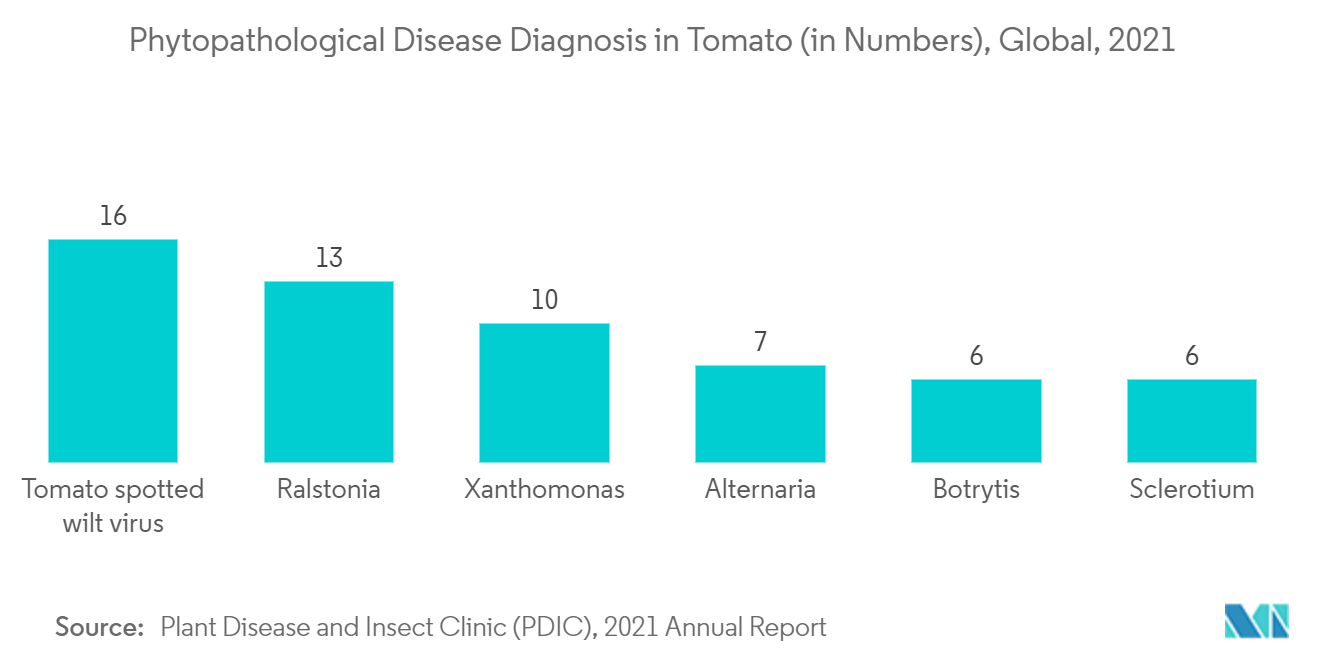
North America Dominates the Market and Expects to do Same Over the Forecast Period
North America is anticipated to witness significant growth in the phytopathological disease diagnostics market over the forecast period owing to the factors such as the increasing incidence of plant diseases, the presence of well-established diagnostic infrastructure, growing adoption of novel assay technologies.
In addition, the rising government support and funding to protect crops and plants in the region is also contributing to the growth of the market. For instance, in July 2022, the United States Department of Agriculture (USDA) additionally invested USD 14 million to assist agricultural worker training in historically underprivileged communities and boost the sector's resilience.
Furthermore, in February 2022, the United States Department of Agriculture (USDA) allocated more than USD 70 million to support 372 projects under the Plant Protection Act's Section 7721 program to strengthen the nation's infrastructure for pest detection and surveillance, identification, and threat mitigation, to safeguard the nursery production system and to respond to plant pest emergencies. In addition, 28 projects out of the 372 funded in the fiscal year 2022 are funded by the National Clean Plant Network. Also, from the same source, The National Clean Plant Network (NCPN) aids in keeping up the infrastructure required to guarantee that planting materials that have been certified as being pathogen, disease, and pest-free are accessible to American specialty crop producers of fruit trees, grapes, berries, hops, sweet potatoes, and roses.
Moreover, the rising research and development activities and increased product launches in the region are expected to propel market growth over the forecast period. For instance, in July 2021, researchers from North Carolina State University developed a patch, a wearable sensor, that can continuously monitor plant diseases or other stresses, such as crop damage or extreme heat by measuring the volatile organic compounds (VOCs) emitted by plants. Also, in January 2021, Agdia, Inc. launched an ELISA reagent set for the detection of the tomato brown rugose fruit virus (ToBRFV).
Thus, owing to the aforementioned factors, the market is expected to grow significantly during the forecast period.
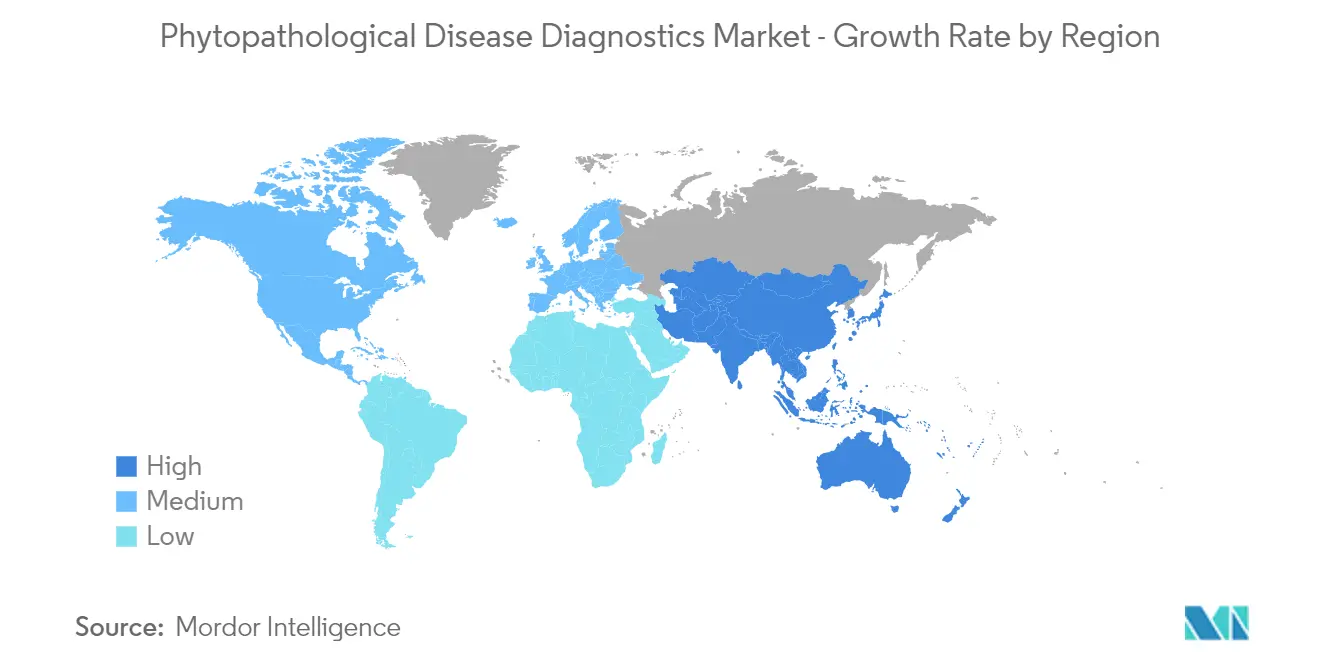
Phytopathological Disease Diagnostics Industry Overview
The global phytopathological disease diagnostics market is competitive and consists of a few major players. Companies like Abingdon Health, Agdia, Inc., BIOREBA AG, Creative Diagnostics, LOEWE Biochemica GmBH, Norgen Biotek Corp., Qualiplante SAS, TwistDx Limited, among others, hold a substantial market share in the market.
Phytopathological Disease Diagnostics Market Leaders
-
Creative Diagnostics
-
Agdia, Inc.
-
Norgen Biotek Corp.
-
Abingdon Health
-
TwistDx Limited
*Disclaimer: Major Players sorted in no particular order
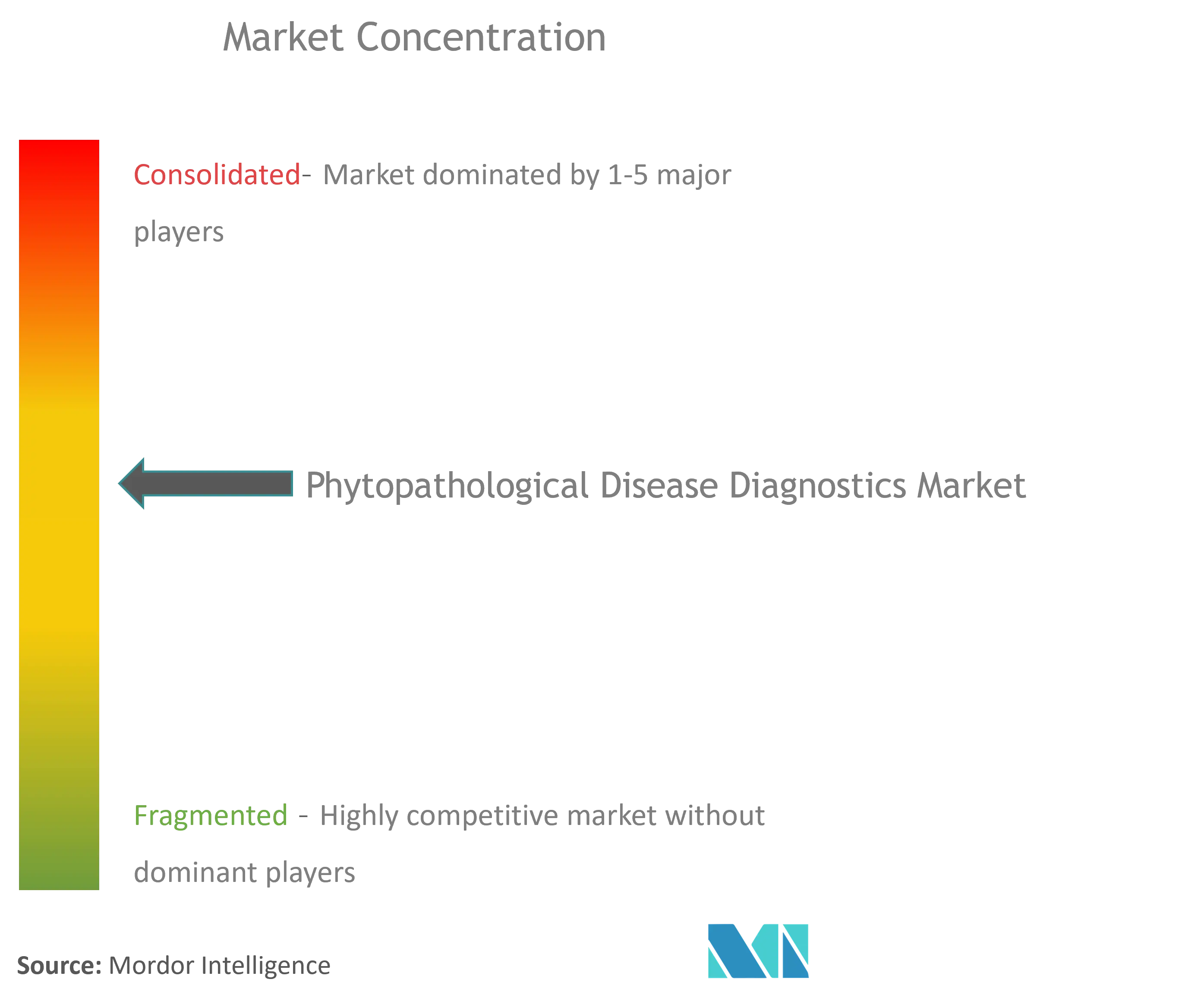
Phytopathological Disease Diagnostics Market News
- In August 2022, Agdia, Inc. commercialized an RNA-based assay, on their AmplifyRP XRT platform, for the detection of Lettuce chlorosis virus. The assay is based on recombinase polymerase amplification (RPA), an isothermal technology, that promotes the rapid amplification and detection of nucleic acid targets, DNA or RNA, at a single operating temperature of 42-degree celsius.
- In October 2021, Agdia, Inc. launched a rapid, user-friendly DNA-based assay for the detection of Quarantine bacteria called Ralstonia solanacearum which affects numerous crops worldwide.
Phytopathological Disease Diagnostics Market Report - Table of Contents
1. INTRODUCTION
- 1.1 Study Assumptions and Market Definition
- 1.2 Scope of the Study
2. RESEARCH METHODOLOGY
3. EXECUTIVE SUMMARY
4. MARKET DYNAMICS
- 4.1 Market Overview
-
4.2 Market Drivers
- 4.2.1 Benefits of Rapid and Accurate Diagnosis of Phytopathological Diseases
- 4.2.2 Increasing Prevalence of Phytopathological Disease
-
4.3 Market Restraints
- 4.3.1 Lack of Skilled Personnel and Limited Knowledge About Plant Health
-
4.4 Porter's Five Force Analysis
- 4.4.1 Threat of New Entrants
- 4.4.2 Bargaining Power of Buyers/Consumers
- 4.4.3 Bargaining Power of Suppliers
- 4.4.4 Threat of Substitute Products
- 4.4.5 Intensity of Competitive Rivalry
5. MARKET SEGMENTATION (Market Size by Value - USD million)
-
5.1 By Product
- 5.1.1 Kits
- 5.1.2 Lateral Flow Devices
- 5.1.3 Accessories and Other Consumables
-
5.2 By Technology
- 5.2.1 PCR-based Assays
- 5.2.2 Serological Tests
- 5.2.3 Isothermal Amplification Assays
- 5.2.4 Other Technologies
-
5.3 By End-user
- 5.3.1 Academic and Research Institutes
- 5.3.2 Food Processing Laboratories
- 5.3.3 Others
-
5.4 Geography
- 5.4.1 North America
- 5.4.2 Europe
- 5.4.3 Asia-Pacific
- 5.4.4 Rest of the World
6. COMPETITIVE LANDSCAPE
-
6.1 Company Profiles
- 6.1.1 Abingdon Health
- 6.1.2 Agdia, Inc.
- 6.1.3 BIOREBA AG
- 6.1.4 Creative Diagnostics
- 6.1.5 LOEWE Biochemica GmBH
- 6.1.6 Norgen Biotek Corp.
- 6.1.7 Qualiplante SAS
- 6.1.8 TwistDx Limited
- *List Not Exhaustive
7. MARKET OPPORTUNITIES AND FUTURE TRENDS
** Subject To AvailablityPhytopathological Disease Diagnostics Industry Segmentation
As per the scope of the report, phytopathology or plant pathology is the science of diagnosing and managing plant diseases. It covers all infectious agents that attack plants and abiotic disorders but does not include herbivory by insects, mammals, etc. Some of the phytopathological diseases are tobacco mosaic virus, rust of wheat, potato mosaic disease, tundu disease of wheat, crown gall disease, and others. The Phytopathological Disease Diagnostics Market is segmented by Product (Kits, Lateral Flow Devices, Accessories, and Other Consumables), Technology (PCR-based Assays, Serological Tests, Isothermal Amplification Assays, and Other Technologies), End-User (Academic and Research Institutes, Food Processing Laboratories, and Others), and Geography (North America, Europe, Asia Pacific and Rest of the World). The report offers the value (in USD million) for the above segments.
| By Product | Kits |
| Lateral Flow Devices | |
| Accessories and Other Consumables | |
| By Technology | PCR-based Assays |
| Serological Tests | |
| Isothermal Amplification Assays | |
| Other Technologies | |
| By End-user | Academic and Research Institutes |
| Food Processing Laboratories | |
| Others | |
| Geography | North America |
| Europe | |
| Asia-Pacific | |
| Rest of the World |
Phytopathological Disease Diagnostics Market Research FAQs
What is the current Global Phytopathological Disease Diagnostics Market size?
The Global Phytopathological Disease Diagnostics Market is projected to register a CAGR of 4.40% during the forecast period (2024-2029)
Who are the key players in Global Phytopathological Disease Diagnostics Market?
Creative Diagnostics , Agdia, Inc. , Norgen Biotek Corp. , Abingdon Health and TwistDx Limited are the major companies operating in the Global Phytopathological Disease Diagnostics Market.
Which is the fastest growing region in Global Phytopathological Disease Diagnostics Market?
Asia Pacific is estimated to grow at the highest CAGR over the forecast period (2024-2029).
Which region has the biggest share in Global Phytopathological Disease Diagnostics Market?
In 2024, the North America accounts for the largest market share in Global Phytopathological Disease Diagnostics Market.
What years does this Global Phytopathological Disease Diagnostics Market cover?
The report covers the Global Phytopathological Disease Diagnostics Market historical market size for years: 2019, 2020, 2021, 2022 and 2023. The report also forecasts the Global Phytopathological Disease Diagnostics Market size for years: 2024, 2025, 2026, 2027, 2028 and 2029.
Phytopathological Disease Diagnostics Industry Report
Statistics for the 2024 Phytopathological Disease Diagnostics market share, size and revenue growth rate, created by Mordor Intelligence™ Industry Reports. Phytopathological Disease Diagnostics analysis includes a market forecast outlook to 2029 and historical overview. Get a sample of this industry analysis as a free report PDF download.



